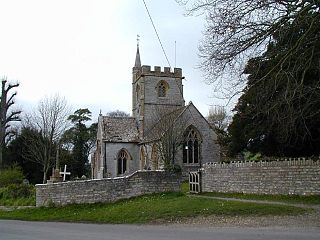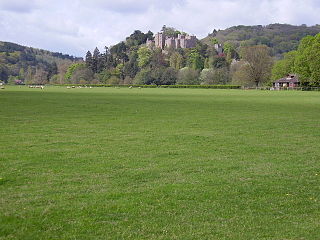
Charlton House is a Grade II* listed house in Charlton Mackrell, Somerset.

Charlton House is a Grade II* listed house in Charlton Mackrell, Somerset.
Charlton House was built in 1726, with later extensions. [1] The property, then known as Lanchers, was owned by the Lyte family of Lytes Cary from 1540, and Thomas Lyte (died 1748) built Charlton House in 1726. [1]
In 1726, Lyte settled the house on his daughter Silvestra on her marriage to Thomas Blackwell, rector of St Clement Danes, London. [2] Their two daughters Silvestra, wife of James Monypenny, and Mary sold the house to John Pyne of Low Ham in 1758. [2]
John Pyne died in 1791, and left the house and lands to his son William, who conveyed them to Robert Clarke of Castle Cary in 1794, who in turn sold the estate to John Jerritt in 1800. [2] Jerritt owned the house from 1800 to 1806, and diverted the Kingweston Road further west, and the old road became the carriage drive to the house. [1]
In 1806, it was bought was by Lionel Lukin, then by John Whitelocke in 1809, and by William Dickinson in 1811. [2] Along with the manor of Charlton Mackrell, the house remained in the Dickinson family until 1930, including the politician, Francis Henry Dickinson when it was sold by his grandson, William Francis Dickinson. [2] [3]

Alford is a village and parish on the River Alham, in Somerset, England, situated 8 miles (12.9 km) south of Shepton Mallet and two miles west of Castle Cary in the South Somerset district. The village has a population of 63.

Charlton Mackrell is a village in civil parish of The Charltons, in the county of Somerset, England, situated 3 miles (5 km) east of Somerton in the South Somerset district. The village has a population of 1,020.

Trafalgar Park is a large Georgian country house about 1.4 miles (2.3 km) northeast of the village of Downton in south Wiltshire, England, and 4.5 miles (7.3 km) southeast of the city of Salisbury. It was built in 1733 and is now a Grade I listed building. The house stands in extensive grounds on the left bank of the River Avon, opposite Charlton-All-Saints.
The High Sheriff of Monaghan was the British monarch's representative in County Monaghan, a territory known as his bailiwick. Selected from three nominated people, he held his office over the duration of a year. He had judicial, ceremonial and administrative functions and executed High Court Writs.

John Cecil, 5th Earl of Exeter, known as Lord Burghley until 1678, was a British peer and Member of Parliament. He was also known as the Travelling Earl.

Lytes Cary is a manor house with associated chapel and gardens near Charlton Mackrell and Somerton in Somerset, England. The property, owned by the National Trust, has parts dating to the 14th century, with other sections dating to the 15th, 16th, 18th, and 20th centuries. "Yet all parts blend to perfection with one another and with the gentle sunny landscape that surrounds them," comments Nikolaus Pevsner. The House is listed as Grade I by English Heritage.

Henry Lyte was an English botanist and antiquary. He is best known for two works, A niewe Herball (1578), which was a translation of the Cruydeboeck of Rembert Dodoens, and an antiquarian volume, The Light of Britayne (1588), both of which are dedicated to Queen Elizabeth I.
Sir Charles Turner, 1st Baronet was a British politician and Lord Mayor of York.
Horsley Priory was a medieval, monastic house in Gloucestershire, England.
The Somerset Victoria County History is an encyclopaedic history of the county of Somerset in England, forming part of the overall Victoria County History of England founded in 1899 in honour of Queen Victoria. With ten volumes published in the series A History of the County of Somerset, the Somerset VCH is among the most substantial of the Victoria County Histories.

Twickenham Park was an estate in Twickenham in south-west London.

The feudal barony of Dunster was an English feudal barony with its caput at Dunster Castle in Somerset. During the reign of King Henry I (1100–1135) the barony comprised forty knight's fees and was later enlarged. In about 1150 the manors retained in demesne were Dunster, Minehead, Cutcombe, Kilton and Carhampton in Somerset, and Ham in Dorset.
Ralph Lambert (1667–1731) was an Irish Anglican priest in the first half of the 18th century.
William Thomas Parr Brymer was Archdeacon of Bath from his installation on 1 April 1840 until his death on 19 August 1852.

Tor Mohun is a historic manor and parish on the south coast of Devon, now superseded by the Victorian sea-side resort of Torquay and known as Tormohun, an area within that town. In 1876 the Local Board of Health obtained the sanction of Government to alter the name of the district from Tormoham (sic) to Torquay.

St Luke's Church in Charlton, London, England, is an Anglican parish church in the Diocese of Southwark.
The Court is a Grade II* listed house, and former rectory, in Charlton Mackrell, Somerset.
William Dickinson (1771–1837) was an English politician, in parliament from 1796 to 1831.

Buckenham Tofts is a now deserted historic parish and manor in Norfolk, England, situated about 7 miles north of Thetford, and since 1942 situated within the Stanford Training Area, a 30,000-acre military training ground closed to the public. It was situated about one mile south of the small village of Langford, with its Church of St Andrew, and about one mile west of Stanford, with its All Saints' Church and one mile north of West Tofts, with its Church of St Mary, all deserted and demolished villages. None of these settlements are shown on modern maps but are simply replaced by "Danger Area" in red capital letters. It is situated within Breckland heath, a large area of dry sandy soil unsuited to agriculture. The parish church of Buckenham Tofts, dedicated to St Andrew, was demolished centuries ago and stood to the immediate north of Buckenham Tofts Hall, the now-demolished manor house, as is evidenced by a graveyard which was discovered in that location. The parishioners, few as they were, used nearby St Mary's Church, West Tofts, one mile to the south, where survive 18th-century monuments to the Partridge family of Buckenham Tofts. In 1738 the Norfolk historian Blomefield stated of Buckenham Tofts "there is nothing remaining of this old village, but the Hall, and the miller's house". The ancient manor house was rebuilt in 1803 by the Petre family in the Georgian style and on a grand scale, was sold with the large estate in 1904 and was finally demolished by the army in 1946, having suffered major damage from military training exercises and shelling. In the early 21st century the remains of the manor house were described as follows: "a grassy platform of raised ground and beside a short line of dilapidated stone steps. The raised ground made a sort of elevated lawn, large enough for a tennis court or two, and the steps went to the top of the platform, and then went nowhere."
Lancelot Holland, also Launcelot (1781–1859) was a British Army officer and diarist. In later life he went into business, and became a company director. He was also a noted bibliophile and collector..